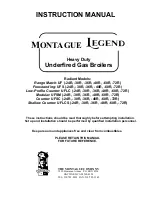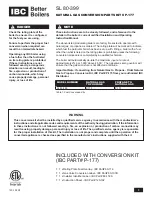
SAFETY DEVICE TESTING
CHAPTER 6 SAFETY DEVICE TESTING
6.1 TESTING OF SAFETY DEVICES
Periodic safety device testing is required to
ensure that the control system and safety
devices are operating properly. The Benchmark
2.0LN control system comprehensively monitors
all combustion-related safety devices before,
during and after the start sequence. The
following tests check to ensure that the system
is operating as designed.
Operating controls and safety devices should be
tested on a regular basis or following service or
replacement. All testing must conform to local
codes such as ASME CSD-1.
NOTE
MANUAL and AUTO modes of operation
are required to perform the following
tests. Refer to Chapter 3.
NOTE
It will be necessary to remove the front
door, top panel and side panels from the
unit to perform the following tests.
WARNING
ELECTRICAL VOLTAGES IN THIS
SYSTEM INCLUDE 120 AND 24
VOLTS AC. POWER MUST BE RE-
MOVED PRIOR TO PERFORMING
WIRE REMOVAL OR OTHER TEST
PROCEDURES THAT CAN RESULT
IN ELECTRICAL SHOCK.
6.2 LOW GAS PRESSURE FAULT TEST
Refer to Figure 6-1 and ensure that the ball
valve located at the low gas pressure switch is
closed.
1. Remove the 1/8“ plug from the ball valve at
the low gas pressure switch shown in Figure
6-1.
2. Install a 0 – 16“ W.C. manometer or a W.C.
gauge where the 1/8" plug was removed.
3. Slowly open the ball valve at the low gas
pressure switch.
4. Start the unit in Manual Mode and adjust the
firing rate to between 25 and 30%.
5. While the unit is firing, slowly close the
external manual gas shut-off valve.
6. The unit should shut down and display a
LOW GAS PRESSURE
fault message at
approximately 2.6” W.C. The
FAULT
indi-
cator should also start flashing.
7. Fully open the external manual gas shut-off
valve and press the
CLEAR
button on the
Control Box.
8. The fault message should clear and the
FAULT
indicator should go off. The unit
should restart.
9. Upon test completion, close the ball valve at
the low gas pressure switch and remove the
manometer. Replace the 1/8“ plug removed
in step 1.
Figure 6-1
Low & High Gas Pressure Testing
6.3 HIGH GAS PRESSURE TEST
To simulate a high gas pressure fault, the gas
pressure will be gradually increased using the
adjustment screw on the SSOV regulator. This
adjustment is located behind the brass hex head
cap shown in Figure 4-3. Perform the test as
follows:
1. Refer to Figure 6-1 and remove the 1/8“ plug
from the ball valve at the high gas pressure
switch.
2. Install a 0 – 16” W.C. manometer or W.C.
gauge where the 1/8” plug was removed.
6-1
Summary of Contents for GF-123
Page 4: ......
Page 8: ......
Page 36: ......
Page 42: ......
Page 68: ......
Page 76: ......
Page 78: ......
Page 84: ......
Page 89: ...APPENDIX F F 5 ...
Page 92: ...APPENDIX F F 8 ...
Page 94: ...APPENDIX F F 10 ...
Page 96: ...APPENDIX F F 12 ...
Page 100: ...APPENDIX G G 4 ...
Page 106: ......
Page 107: ...APPENDIX J BENCHMARK CONTROL PANEL EXPLODED VIEW J 1 ...
Page 108: ...APPENDIX J J 2 P1 P2 P3 P4 P5 P6 BENCHMARK CONTROL PANEL REAR VIEW ...
















































